Butterflies and Moths
Media
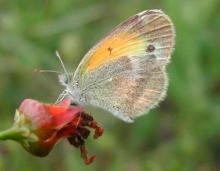
Species Types
Scientific Name
Nathalis iole
Description
Each year, dainty sulphurs arrive in Missouri from regions to our south. They are small compared to other sulphur butterflies. The wingspan of the largest individuals reaches only about 1¼ inches.
Media

Species Types
Scientific Name
Pyrisitia lisa (syn. Eurema lisa)
Description
The little yellow is just what the name says it is. The lower side is yellow with a few spots, including two tiny black spots on the basal hindwing and, often, a larger rusty spot on the hindwing margin.
Media

Species Types
Scientific Name
Colias eurytheme
Description
One of the most common butterflies in Missouri, the orange sulphur often gathers in numbers in moist places.
Media
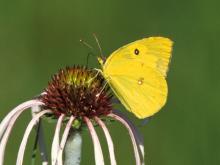
Species Types
Scientific Name
Zerene cesonia (formerly Colias cesonia)
Description
The southern dogface has a dog’s head pictured on its yellow forewings. It repopulates our state each year from the south.
Media
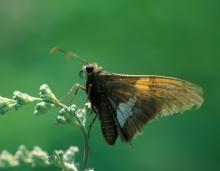
Species Types
Scientific Name
Epargyreus clarus
Description
In a large, global family of several thousand species, the silver-spotted skipper is one of the easiest to identify in our state.
Media
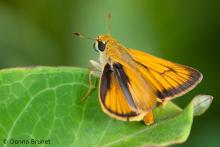
Species Types
Scientific Name
Anatrytone logan
Description
The undersides of the Delaware skipper's wings are solid orange. It's found statewide in a variety of habitats.
Media

Species Types
Scientific Name
Hylephila phyleus
Description
Fiery skippers have plain orange undersides scattered with a sprinkling of small dark spots. Males have flame-shaped orange patches on the hindwing upper surface.
Media

Species Types
Scientific Name
Polites peckius
Description
Peck’s skipper is found in Missouri’s fields, lawns, and other open habitats from May through October. Identify it by the one yellow hindwing rectangle that is wider than the others.
Media
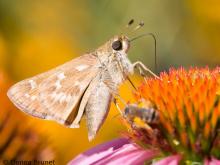
Species Types
Scientific Name
Atalopedes campestris
Description
Found statewide in grassy, open places, the sachem gets its name from the boldness of the males, which approach and chase away intruders — even people!
Media

Species Types
Scientific Name
Euphydryas phaeton ozarkae
Description
The Baltimore checkerspot is unforgettable. In Missouri it is locally abundant in the eastern Ozarks, but rare elsewhere.
See Also


Media

Species Types
Scientific Name
About 1,500 species in North America north of Mexico
Description
Adult caddisflies are mothlike. Their larvae are aquatic and build portable, protective cases out of local materials, including grains of sand, bits of leaves and twigs, and other debris.
Media

Species Types
Scientific Name
Corydalus cornutus
Description
Adult eastern dobsonflies are huge and mothlike, with large wings and a weak, fluttery flight. The fiercely predaceous aquatic larvae, called hellgrammites, are well-known to anglers, who often use them as bait.
About Butterflies and Moths in Missouri
Butterflies, skippers, and moths belong to an insect order called the Lepidoptera — the "scale-winged" insects. These living jewels have tiny, overlapping scales that cover their wings like shingles. The scales, whether muted or colorful, seem dusty if they rub off on your fingers. Many butterflies and moths are associated with particular types of food plants, which their caterpillars must eat in order to survive.





















